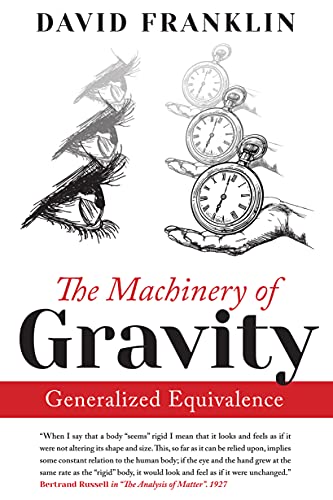
Challenging some of the greatest minds and accepted concepts in modern physics, The Machinery of Gravity: Generalized Equivalence by David Franklin is a thought-provoking proposal of a paradigm shift in modern physics.
While this may sound like a daunting work to digest, the author does an exceptionally good job of keeping this high-level material accessible for a broad range of readers. With a disarmingly upfront style of narration, this book lays out our present understanding of physics, alongside streams of fascinating questions that seem to poke holes, or at least find loose threads, in our current conceptions of science.
At its core, the book is a vehicle for the concept of Generalized Equivalence (GEQ), a radical new hypothesis founded on gravity being a repelling force caused by the universe’s perpetual expansion, rather than the attractive force that holds us all on the ground. In practical terms, this change in thinking wouldn’t alter our relationship to gravity, but the concept of everything in the universe “growing towards one another” is a dramatic departure from the widely accepted tenets of academics around the world.
Franklin does not approach this contentious argument unprepared – he methodically moves through well-known aspects of physics, countering accepted theorems and equations with his own derivations and explanations, backed by logic and mathematics, but fueled by a fundamental shift in perspective. As the text moves past thermodynamics, general relativity, and time dilation, each boasting its own thorough summaries (and objections), the more theoretical aspect of Franklin’s idea comes into focus. By combining elements of General Relativity (GR) and Newtonian physics, the GEQ theory doesn’t fully bridge the two, but does answer some major astrophysical questions.
Franklin is quick to note that while a century of study on General Relativity has not suggested it is false, some phenomena have been observed that cannot be explained by GR, and this is the gap GEQ proposes to fill. The claim that GEQ can account for the bending of starlight and the behavior of spiral galaxies – without the blank check of dark matter as the explanation – is well-expounded by Franklin in a series of confident chapters that are perhaps the most interesting of the book, as they directly apply this new theory to a current mystery.
On a more heady, philosophical level, the tenets of these two theories aren’t necessarily aligned, meaning that it doesn’t seem possible for both to be correct. However, to propose GEQ as the “machinery” inside the “black box” of GR is a clever dodge that is a compelling and persuasive vantage point for his argument. Bolstered by ample diagrams and a patient, professorial style of explication, it is difficult not to accept this proposed idea as fact.
In terms of the prose, there are few errors or mistakes to adjust, aside from the occasional word reversal or missed comma, which are far outweighed by the author’s attention to detail. The layout and structure of the book are also excellent; the chapter summaries to introduce key concepts in layman’s terms are inclusive and appreciated, and will likely keep readers engaged for longer. A balance between high-level and common language is difficult to maintain, but even for novice stargazers, this deep dive into gravity’s secrets and systems is an academic but accessible thrill that will appeal to physicists and laypeople alike, given the incredible implications for science.
Book Links
STAR RATING
Design
Content
Editing
Get an Editorial Review | Get Amazon Sales & Reviews | Get Edited | Publish Your Book | Enter the SPR Book Awards | Other Marketing Services























Leave A Comment